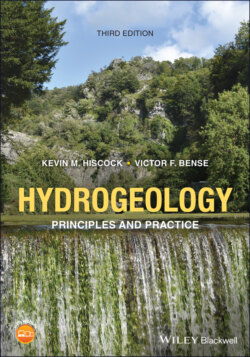Читать книгу Hydrogeology - Kevin M. Hiscock - Страница 27
1.5.3 Groundwater discharge to the oceans
ОглавлениеThe approximate breakdown of direct groundwater discharge from continents to adjacent oceans and seas was estimated by Zektser and Loaiciga (1993) as follows: Australia 24 km3 a−1; Europe 153 km3 a−1; Africa 236 km3 a−1; Asia 328 km3 a−1; the Americas 729 km3 a−1; and major islands 914 km3 a−1. The low contribution from the Australian continent of direct groundwater discharge, despite its relatively large territory, is attributed to the widespread occurrence of low‐permeability surface rocks that cover the continent. At the other extreme, the overall proximity of recharge areas to discharge areas is the reason why major islands of the world contribute over one‐third of the world’s direct groundwater discharge to the oceans. The largest direct groundwater flows to oceans are found in mountainous areas of tropical and humid zones and can reach 10–15 × 10−3 m3 s−1 km−2. The smallest direct groundwater discharge values of 0.2–0.5 × 10−3 m3 s−1 km−2 occur in arid and arctic regions that have unfavourable recharge and permeability conditions (Zektser and Loaiciga 1993).
In a later study presented by Luijendijk et al. (2020), the application of a spatially resolved, density‐driven global model of coastal groundwater discharge showed that the contribution of fresh groundwater to the world’s oceans is equal to 224 (range 1.4–500) km3 a−1, and accounts for approximately 0.6% (range 0.004–1.3%) of the total freshwater input and approximately 2% (range 0.003–7.7%) of the solute input of carbon, nitrogen, silica and strontium. The uncertainty ranges reported are mostly caused by the high uncertainty of the values of permeability that were used, which is on average two orders of magnitude. Additional sources of uncertainty are the representative topographic gradient of coastal watersheds, groundwater recharge, and the size of the area that contributes to coastal groundwater discharge.
The coastal discharge of freshwater showed a high spatial variability. For an estimated 26% (0.4–39%) of the world's estuaries, 17% (0.3–31%) of salt marshes and 14% (0.1–26%) of coral reefs, the flux of terrestrial groundwater exceeds 25% of the river flux and poses a risk for pollution and eutrophication. Catchments with hotspots of coastal groundwater discharge, where coastal groundwater discharge exceeds 100 m2 a−1 and 25% of the river discharge, were located predominantly in areas with a steep coastal topography due to glacio‐isostatic rebound, active tectonics or volcanic activity, and in areas consisting of permeable unconsolidated sediments, carbonates or volcanic rocks. The distribution of these hotspots is consistent with reported sites of high fresh groundwater discharge found in North America, Europe and East Asia. However, at many hotspots, such as Iceland and parts of South America, Africa and South Asia, and many tropical islands, coastal groundwater discharge requires further exploration. In summary, Luijendijk et al. (2020) concluded that fresh groundwater discharge is insignificant for the world’s oceans, but important for coastal ecosystems. For further discussion of groundwater discharge to the oceans, see Section 2.16.
